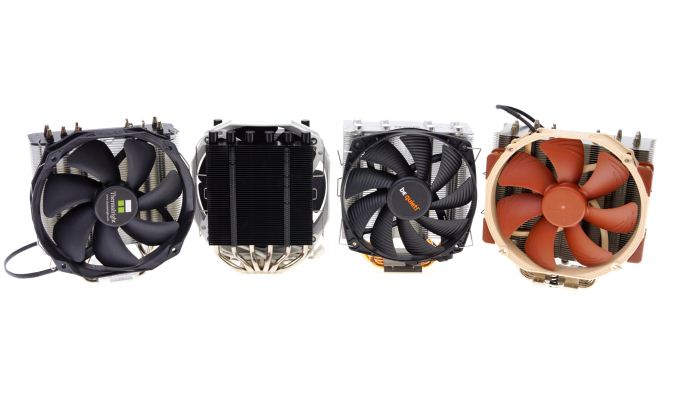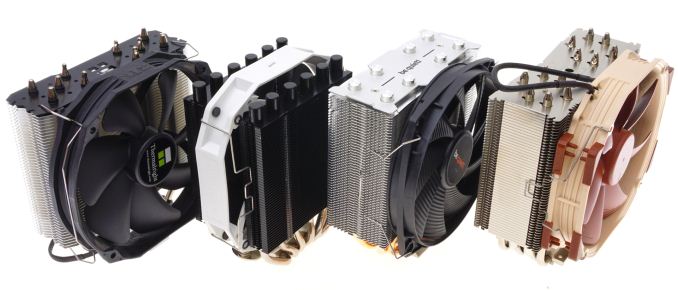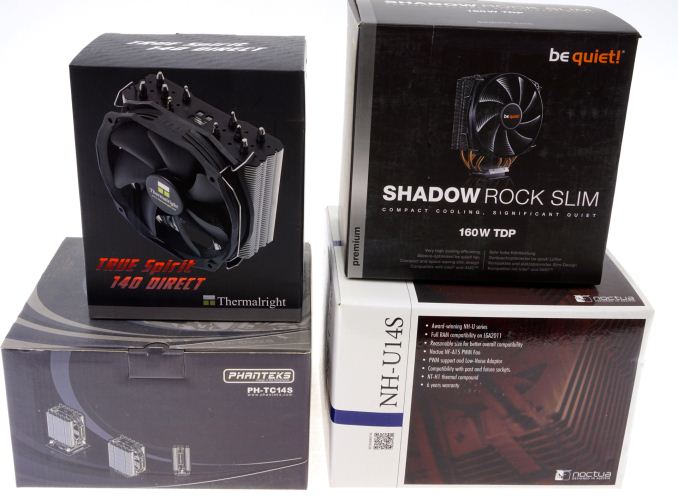The 140mm Slim Tower CPU Cooler Roundup: Thin & Light Done Just Right
by E. Fylladitakis on May 24, 2017 8:00 AM EST- Posted in
- Cases/Cooling/PSUs
- be quiet!
- Noctua
- Phanteks
- Cooler
- Thermalright

A standard cooler is supplied with nearly all retail boxed CPUs, which guarantees adequate cooling performance under normal operating conditions. Enthusiasts however are rarely satisfied with the performance of stock CPU coolers, seeking either better overall performance or lower noise levels. This is especially true for those who are planning to overclock their systems, as the supplied coolers usually don't have the extra performance required for handling overdriven processors.
However, the selection of a CPU cooler is a complicated matter. It depends on the available space, the user’s needs and wants, as well as on the available budget. For example, some users might require high performance but low profile coolers due to limited space, while others may have spacious cases and high enough budgets to afford a huge dual-tower cooler.
In today's review we will be having a look at some of the most popular single tower 140 mm CPU coolers currently available. Considering that height usually is the primary concern with CPU coolers, single tower 140 mm coolers virtually have the same space requirements as the dual tower 140 mm coolers do. Their distinct advantages however are much lower weight and significantly more competitive pricing. This makes them ideal for users that do have the available space, but do not require the performance of a dual-tower behemoth or move their system often, in which case the cooler’s weight becomes a major safety concern.
 Thermalright True 140 Direct, Phanteks PH-TC14S, Be Quiet! Shadow Rock Slim, & Noctua NH-U14S
Thermalright True 140 Direct, Phanteks PH-TC14S, Be Quiet! Shadow Rock Slim, & Noctua NH-U14S
The four coolers that we are taking a look at in this roundup review are the: Noctua NH-U14S, Phanteks PH-TC14S, Thermalright True Spirit 140 Direct, and the Be Quiet! Shadow Rock Slim. All four of these coolers have similar space requirements and pricing, but they are certainly not created equal. We will have a closer look at their individual strengths and weaknesses in the following pages of this review.
| 140mm Tower CPU Coolers | ||||
| Product | Fan(s) | Fan Speed (RPM) | Height (mm/in) | Current Retail Pricing |
| Noctua NH-U14S | 1 × 140 mm | 1500 RPM | 165 mm / 6.5” | $65 |
| Phanteks PH-TC14S | 1 × 140 mm | 1300 RPM | 160 mm / 6.3” | $50 |
| ThermalRight True Spirit 140 Direct | 1 × 140 mm | 1600 RPM | 161 mm / 6.34” | $47 |
| Be Quiet! Shadow Rock Slim | 1 × 140 mm | 1400 RPM | 161 mm / 6.34” | $50 |











74 Comments
View All Comments
Ian Cutress - Wednesday, May 24, 2017 - link
Are you measuring the heatsink, or the product? A lot of these companies go to great lengths to 'optimize' their fan design.fanofanand - Thursday, May 25, 2017 - link
I see this same type of comment applied to GPUs and cases too. Products should be tested exactly as they are sold. If a company wants to get their price under $x and they skimp on the case fans to do it, the reader should know that so they can price it appropriately by adding in the cost of good fans. Conversely if a company's price is higher but out of the box has the performance you would achieve from changing out the fans then that should be acknowledged and the reader be made aware. The way Anandtech does it is absolutely appropriate and allows the reader to get an accurate picture of what they are getting for the money.snarfbot - Thursday, May 25, 2017 - link
right, and like i said that is good, but when it comes to evaluating what product is best at specific noise levels the picture becomes less clear.isolating the performance of each cooler by using the same fan on each would help in that regard, and would be a cogent data point regardless imo.
in your testing methodology page you didnt mention whether you were using the boxed tim, or something like arctic silver for all products, as it is commonly accepted as the standard by which other tims are measured against in tech circles. i prefer mx-4, because its easier to use, but its good to have a standard to measure against.
you might do that to eliminate one variable from your test, and the same argument could be made for using one common fan across the board for that reason.
Infy2 - Wednesday, May 24, 2017 - link
Some comment on the difficulty of installation would be helpful. The inlcuded Noctua cooler has repuation of being easy to install while the Thermalright is not.gradoman - Saturday, May 27, 2017 - link
Late reply, but Thermalright's installation method is pretty simple these days. I'd say a half-step below Noctua's mounting system, but you're not going to be struggling to pin down sprung screws.https://youtu.be/EDRNBCH1lRA?t=1760
sheh - Wednesday, May 24, 2017 - link
Would be interesting to know their weights.Sivar - Wednesday, May 24, 2017 - link
Thank you for the useful, thorough review!Daisho11 - Wednesday, May 24, 2017 - link
It would be interesting to see how these heatsinks perform when they all use the same fan. Maybe test them all with the Noctua fan or some other popular variant (Corsair, GentleTyphoon, SanAce, etc.)Lolimaster - Thursday, May 25, 2017 - link
The efficieny and temps of Ryzen are so nice that you don't need AIO or big tower coolers, most of the time the stock cooler is more than enough, and it's silent :DI think the best cooler for Ryzen is the Coolermaster Hyper 212X, everything else is basically overkill.
Lolimaster - Thursday, May 25, 2017 - link
This will probably be nice for Ryzen 9 monsters.